Dead Of Night (1945)
Directed by: Alberto Cavalcanti, Basil Dearden, Charles Crichton, Robert Hamer
Written by: Angus MacPhail, E.F. Benson, H.G. Wells, John Baines, T.E.B. Clarke
Starring: Mary Merrall, Mervyn Johns, Michael Redgrave, Roland Culver
HCF REWIND NO. 162: DEAD OF NIGHT [1945]
AVAILABLE ON DVD
RUNNING TIME: 99 min
REVIEWED BY: Dr Lenera, HCF Critic
Architect Walter Craig arrives at a country house party where he reveals to the assembled guests that he has seen them all in a dream. He appears to have no prior personal knowledge of them but is able to predict spontaneous events in the house before they unfold. The other guests attempt to test Craig’s foresight, while entertaining each other with various tales of uncanny or supernatural events that they experienced or were told about. A racing car driver survives a crash and keeps seeing a horse-drawn hearse….a girl plays hide-and-seek at a party and discovers a hidden room and a small boy crying….a man is bought an antique mirror by his fiancée and sees in the mirror another room from another age….two golf fanatics both love the same woman and make a strange pact….and, last but certainly not least, a ventriloquist thinks his dummy has a mind of its own….
There seem to be more anthology films in the horror genre than any other, perhaps because it’s easier if you’re scared by one tale to take a break before the next, and every now and again you get a short burst of them. Perhaps one of those bursts, with forthcoming sequels to The ABCs Of Death and Trick ‘r Treat, will be soon, though the heyday of the horror anthology was in the late 60’s/early 70’s, with the studio Amicus producing a whole series beginning with Dr. Terror’s House Of Horrors. In my view though the two best portmanteau chillers are Mario Bava’s Black Sabbath and this particular movie [which is not to be confused with the film of the same title from 1972 which is totally different but good in its own right], which doesn’t seem to be as widely seen and regarded as it ought to be, but certainly influenced the Amicus anthologies and has had certain elements, such as the story about the ventriloquist’s dummy that comes to life, and the ending twist, re-used more than once. It’s about as British as you can get, extremely restrained and ‘civilised’, and I guess it may disappoint many modern viewers used to lots of jump scares, but watched at night, certain parts can still frighten, and sometimes isn’t a slight undercurrent of uneasiness more enjoyable than jumping out of your skin every ten minutes?
Partly because of the extremely tight censorship, there was never a thriving British horror cinema till Hammer burst on to the scene in the late 50’s. In 1942, horror films were banned altogether, the thinking being that the horrors of World War 2 were more than enough for the public to deal with and any more terror would be un-productive. Interestingly, the opposite happened in the US: a greater number of chillers were produced, cinema-goers finding some solace in tales of the supernatural. The ban was lifted in 1945 and the first film out of the gate was Dead Of Night, oddly from Ealing Studios, usually making great comedies. It had four directors, two filming one story each, another filming two stories and the other filming one story and the framing device. They had all made successful films for Ealing, though one director, Charles Frend, had to pull out for unspecified reasons. The distributors were unsure how to market the film, even with some newspapers calling for it to be banned because it was too scary, and it wasn’t the huge hit it deserved to be, meaning that not many similar films were made afterwards. Nor was it much acclaimed, though it did win the award for Most Interesting Screenplay at the obscure Locarno International Film Festival in Switzerland In the US it had two stories removed, meaning that some later scenes in the house made no sense because viewers didn’t know who certain people were. In 1972 Hammer considered remaking it, keeping its 40’s setting. Like many later Hammer projects, it never came to fruition, and for that we can probably be grateful.
The film’s framing device is just one of a great many things that would be imitated in many later films, though certain details were rarely used as effectively. Walter is sure he’s seen the people inside the house he’s in, and said people proceed to tell ghost stories. Sometimes they were the ones who experienced them directly, and sometimes not. After each tale, Dr. Van Straaten proceeds to debunk each one in what becomes a conflict between the irrational and the rational. It’s not long before it becomes obvious what side the film is on, and this may have just been too much for staid viewers and critics in the Britain in 1945. Eventually it climaxes in a frightening hallucinatory climax involving everyone from each story, before a It Was All A Dream ending. I’m not counting this as a spoiler, because we get another ending after this, and it’s really chilling and audacious. It’s also been copied a few times [and I wonder if certain films like Inception were influenced by the Chinese Box plotting?], but rarely done so subtly, the simple sight of a cigarette being lit in slow motion telling you, and perhaps even Walter, though he doesn’t totally realise it, what is actually going on, though certain details, as in many of the best stories of this time, are open to the viewer’s own interpretation.
The stories in an anthology always vary in quality, and so they do in Dead Of Night, though none are actually poor. The Hearse Driver is very short, but quite eerie, as a race car driver has an accident and, whilst recovering in hospital, wakes up and goes towards the curtains in his room. There is considerable suspense before he pulls them back, and sees that it’s daylight outside and there is a hearse where the driver tells him: “just room for one inside, sir”. I’ve often wondered why it is daylight outside rather than night-time, because it may have been more effective set nocturnally, but then one of the themes of the whole film seem to be the incursion of the supernatural into mundane reality. In any case, this tiny tale ends with a second sighting of the driver which is quite jolting [even if he’s very friendly], and it all makes sense. Christmas Party, which references a real murder in 1860 where a 16 year old girl killed her four year old brother, involves an encounter with a ghost by a young girl. It’s very brief too, and only sends shivers up the spine at the end when the girl is told the truth about who she has seen and exhibits fear and tears in a very distressing manner. Then we get into the real scary stuff with The Haunted Mirror, bought by a woman for her fiancée. The scenes where the man sees a totally different room, ornate and Victorian, reflected in the mirror manage to be both eerie and magical at the same time. It is found out that the mirror, whose allure pervades the whole story, belonged to a wife-murderer. The climax to this story is very intense, while the whole thing is acutely disturbing, partly because of comparisons made between the situations of the two couples in the tale.
Time for a light-hearted diversion then, and the H.G. Wells-derived Golfing Story seems to be disliked by many. The Topper-like tale of two golfers, one of whom kills himself over the girl they both love and returns to haunt him, isn’t as funny as it thinks it is but is pleasantly whimsical, has a rather daring and blatantly sexual ending which I’m surprised got through the censors, and isn’t it always great to see Basil Radford and Naunton Wayne rehash their roles from The Lady Vanishes yet again? The last story is The Ventriloquist’s Dummy, and perhaps I find the idea of a dummy developing a mind of its own more frightening than most because I find the whole ventriloquist thing bloodcurdling anyway [I mean why do the dummies look so hideous and have horrible voices?], but this is really the highpoint of Dead Of Night. It features an absolutely brilliant performance by Michael Redgrave, especially in the scene where the narrator sees him for the second time as a broken man drowning his sorrows in a bar and we realise how totally under the control of Hugo the dummy he is. Would you believe it, Redgrave had trained as a ventriloquist so he did Hugo’s voice too, and actually if you look closely you can sometimes see his mouth move a little, but so what? Hugo, the inspiration for countless movie dolls and even some more direct imitations like Devil Doll and the hugely underrated Magic, remains the scariest. Perhaps it’s because we don’t see him move until one hair-raising scene right at the end.
In fact the more I think of it you can see so much of Dead Of Night turning up in later movies: The Ventriloquist’s Dummy had its final scene virtually copied for Psycho [there’s even an identical line of dialogue, The Sixth Sense used some bits from The Christmas Party, From Beyond The Grave borrowed from The Haunted Mirror twice as did some films after, and so on. There’s a quaint feel to much of Dead Of Night which you have to get past, especially in the first few scenes, but it really is essential viewing for any true horror fan. Despite its different directors, it’s amazingly consistent in look and feel – the two Alberto Cavalcanti tales make greater use of shadows than the other stories to highlight certain things but thats’s about it – and even if you’re not frightened by much of it, certain scenes and ideas will disturb and probably stay in the mind. About half of Dead Of Night is rather comforting in the manner of the traditional Christmas ghost story, and about half of it is more and more horrifying the more you think about it.
Rating: 










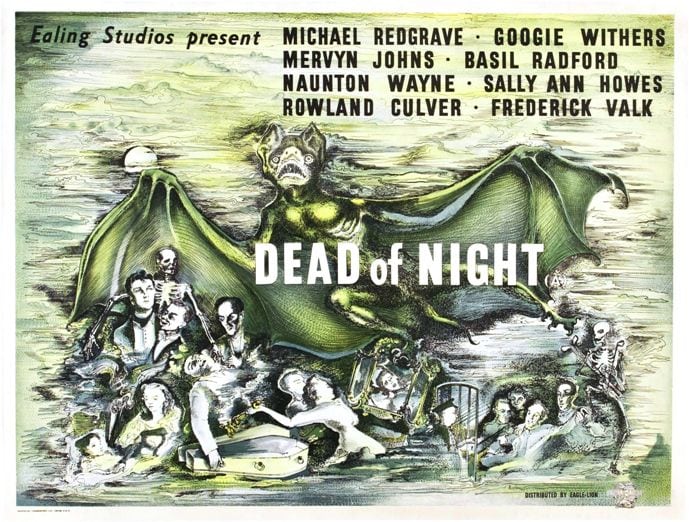
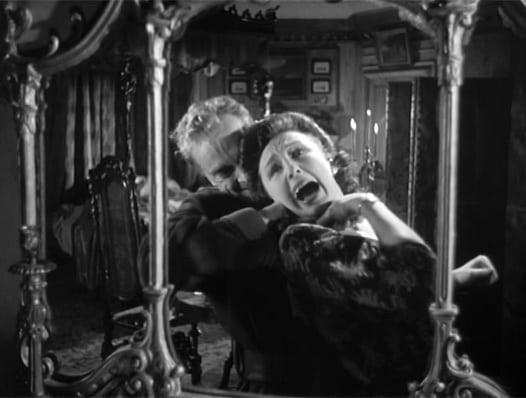
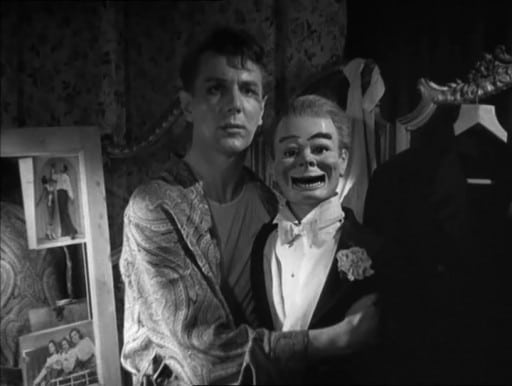

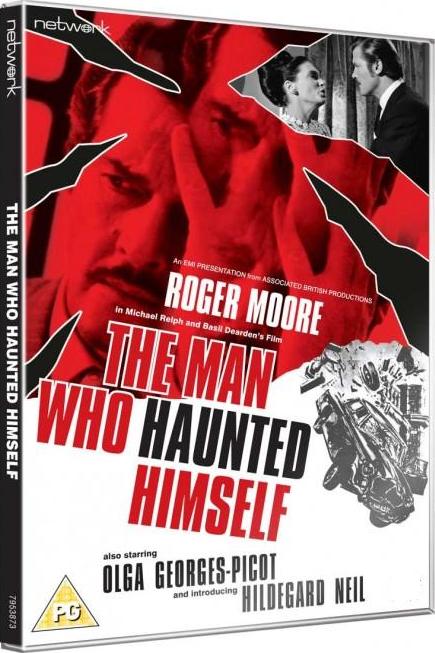
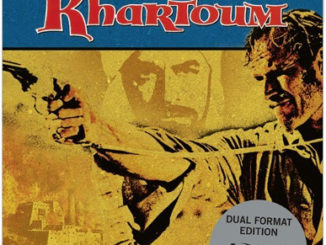
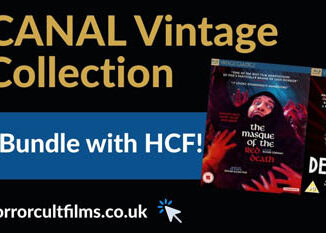
Be the first to comment